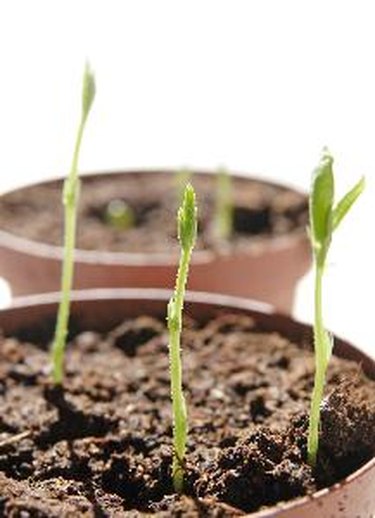
Light is energy and plants use it for fuel. Color signifies the amount of energy carried by light waves and has specific effects on a plant's growth and development. Plants need multiple light colors for effective photosynthesis and sun is only one source of that light. Indoor gardeners can adjust light sources to provide color for various stages of plant growth and save money by choosing efficient lamps and mixed spectrums.
Red Light
Video of the Day
Red light stimulates plants to produce fruit and flowers and is necessary for those activities. Plant pigments absorb red light and control seed germination, bulb formation, root development, dormant periods and the appearance of fruits and flowers. The fruits and flowers are actually triggered by plant hormones that begin the process. But red light alone, or too much red light in the balance, will cause a plant to become spindly, leggy and ultimately fail. Incandescent lighting has traditionally been used for red spectrum light but it has the disadvantage of putting out a lot of heat and using a lot of energy. Broad spectrum fluorescent lights now come with red spectrum lighting, which is balanced with blue light and can be located very close to the plant without the danger of burning delicate leaves and buds.
Video of the Day
Blue Light
Light from the blue spectrum promotes the production of chlorophyll. A plant bathed in blue light should have strong stems and thick, green leaves. The carotenoids in plants absorb the blue light and control leaf fall. Blue light is responsible for a plant's growth toward the light and even the amount of water retained by the plant. An absence or shortage of blue light results in yellowing leaves and plant collapse. Fluorescent bulbs provide good blue light spectrum for plants and LED lighting is now available that efficiently delivers cool blue light as well.
Sunlight
Sunlight is full spectrum light and provides all the color a plant needs for its growth and propagation. If a plant receives some sunlight, a gardener can manipulate it by adding appropriate blue and red spectrum light to encourage healthy growth and fruiting and flowering. For certain plants, like Christmas cactus, this manipulation is the only way to guarantee the plant will be in bloom over the holidays. Pollution can affect the amount of sunlight and the color rays reaching vegetation and the clarity and cleanliness of greenhouse glass can filter sunlight so that plants need supplemental light to thrive.
Why Plants are Green
Plants don't need or use green light. Because they fail to absorb it and reflect it instead, they appear green to us. There are other colors in foliage that are visible and those are caused by pigments, an evolution in response to environmental stress or the result of careful breeding to produce varieties in ornamental plants.